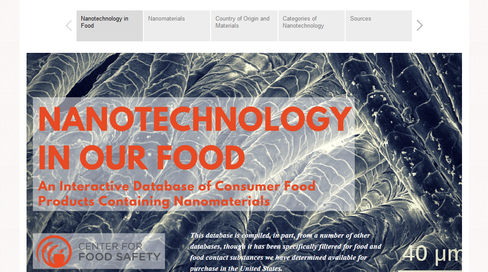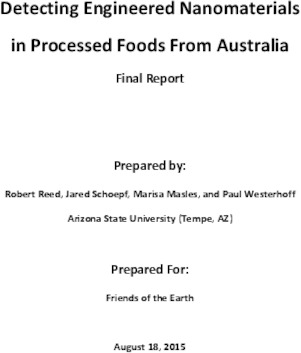From the Open-Publishing Calendar
From the Open-Publishing Newswire
Indybay Feature
New Database Shows Nanotechnology in Common Food Products
October 5, 2015 (Washington, DC)—Center for Food Safety (CFS) today released a new searchable database of consumer food products that contain nanotechnology. Common food related products that contain nanotechnology include candies (M&M’s, Skittles), baby bottles, and plastic storage containers. Nanotechnology is a powerful but novel platform for taking apart and reconstructing nature at the atomic and molecular level with important human and environmental health ramifications. The database contains almost 300 food products and food contact products that use nano.

“Scientists agree that nanomaterials create novel risks that require new forms of toxicity testing. But very little testing and regulation of these new products exists, and consumers have almost no information,” said Jaydee Hanson, senior policy analyst at Center for Food Safety. “This easy to use database is a step to fill the information gap, to alert consumers of just how widespread this technology is and to improve transparency in our food supply.”
Because of their unique properties, nanomaterials pose new risks for human health and the environment. For example, nanomaterials have unprecedented mobility for a manufactured material. Nanomaterials can penetrate human skin and when ingested, reach sensitive places like bone marrow, lymph nodes, the heart, and the brain.
Despite these novel properties, nanomaterials are regulated the same way as larger materials of the same substance. Although they have not been properly evaluated, they are popping up in a wide variety of consumer goods.
The release of the database comes after a new study published by Friends of the Earth (FOE)- Australia that showed the presence of nanomaterials, specifically nano titanium dioxide and nano silica, in all 14 food products the group tested. None of these products were labeled as containing nano ingredients nor were they submitted for nano-specific regulation. Most of these products are being sold in the U.S.
This new database covers over 40 different types of nanomaterials and is the only database to focus exclusively on food and food contact products. Of particular concern is the prominence of nano ingredients in so many foods frequently consumed by children.
“The FDA is failing to prevent nano-laced foods from being sold. Our food safety agency should demand that these products be taken off the market, as companies are using food additives and food contact materials not approved at the nano scale,” said Hanson.
Bulk scale titanium dioxide is used as a food coloring agent, often to make foods look whiter or brighter, but the FDA has not set exposure limits yet for its use at the nano scale in the US. Moreover, the largest review of nano titanium dioxide studies show that many basic questions have not been answered. Candies like M&M’s, processed cheeses, and chewing gum have all been found to contain nano titanium dioxide. Nano titanium dioxide is small enough to cross through the intestine and into organs where it can damage DNA and disrupt cell function.
Silica is an anti-caking agent used in powdered food products, but it, too, could cause health problems at the nano-scale. The European Commission’s Scientific Committee on Consumer Safety (SCCS) found evidence that nano silica can damage DNA and concluded that the data is inadequate and no conclusion of safety can be made. Several recent studies have shown that nano silica can cause liver toxicity.
See the database here: http://salsa3.salsalabs.com/o/1881/p/salsa/web/common/public/content?content_item_KEY=14112%20
http://www.centerforfoodsafety.org/press-releases/4075/new-database-shows-nanotechnology-in-common-food-products
Center for Food Safety
http://www.centerforfoodsafety.org/
Because of their unique properties, nanomaterials pose new risks for human health and the environment. For example, nanomaterials have unprecedented mobility for a manufactured material. Nanomaterials can penetrate human skin and when ingested, reach sensitive places like bone marrow, lymph nodes, the heart, and the brain.
Despite these novel properties, nanomaterials are regulated the same way as larger materials of the same substance. Although they have not been properly evaluated, they are popping up in a wide variety of consumer goods.
The release of the database comes after a new study published by Friends of the Earth (FOE)- Australia that showed the presence of nanomaterials, specifically nano titanium dioxide and nano silica, in all 14 food products the group tested. None of these products were labeled as containing nano ingredients nor were they submitted for nano-specific regulation. Most of these products are being sold in the U.S.
This new database covers over 40 different types of nanomaterials and is the only database to focus exclusively on food and food contact products. Of particular concern is the prominence of nano ingredients in so many foods frequently consumed by children.
“The FDA is failing to prevent nano-laced foods from being sold. Our food safety agency should demand that these products be taken off the market, as companies are using food additives and food contact materials not approved at the nano scale,” said Hanson.
Bulk scale titanium dioxide is used as a food coloring agent, often to make foods look whiter or brighter, but the FDA has not set exposure limits yet for its use at the nano scale in the US. Moreover, the largest review of nano titanium dioxide studies show that many basic questions have not been answered. Candies like M&M’s, processed cheeses, and chewing gum have all been found to contain nano titanium dioxide. Nano titanium dioxide is small enough to cross through the intestine and into organs where it can damage DNA and disrupt cell function.
Silica is an anti-caking agent used in powdered food products, but it, too, could cause health problems at the nano-scale. The European Commission’s Scientific Committee on Consumer Safety (SCCS) found evidence that nano silica can damage DNA and concluded that the data is inadequate and no conclusion of safety can be made. Several recent studies have shown that nano silica can cause liver toxicity.
See the database here: http://salsa3.salsalabs.com/o/1881/p/salsa/web/common/public/content?content_item_KEY=14112%20
http://www.centerforfoodsafety.org/press-releases/4075/new-database-shows-nanotechnology-in-common-food-products
Center for Food Safety
http://www.centerforfoodsafety.org/
Add Your Comments
We are 100% volunteer and depend on your participation to sustain our efforts!
Get Involved
If you'd like to help with maintaining or developing the website, contact us.
Publish
Publish your stories and upcoming events on Indybay.
Topics
More
Search Indybay's Archives
Advanced Search
►
▼
IMC Network



